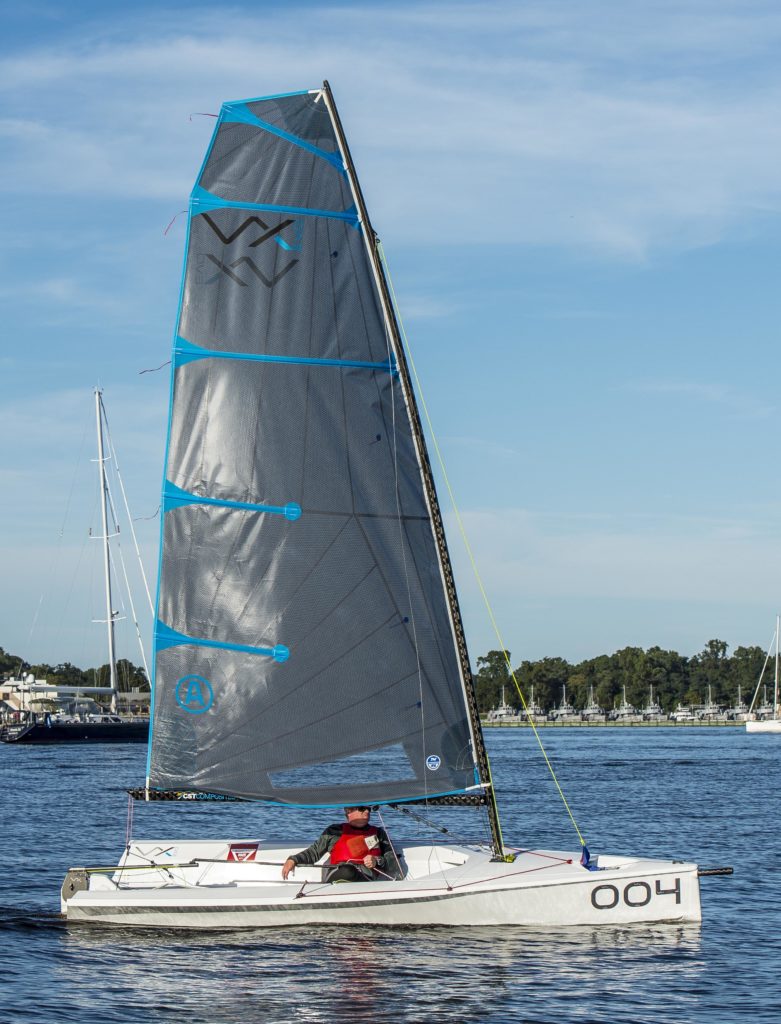Let’s just say — for the sake of argument — that Finn dinghies suddenly vanished from Earth. What then would all the big guys do? The answer from father-and-son sportboat purveyors Brian and Hayden Bennett — who themselves are too large for most 14-foot singlehanders — is the VX Evo. As the elder Brian says, the VX Evo is a “totally strict one-design for Finn-size sailors.” As the creator of the Viper 640 and VX One Design, Brian has been around long enough to know, however, that there are far more average Joes out sailing than hulky Finnster types. To broaden the boat’s appeal, therefore, he and his son have developed three different sail sizes (essentially 10, 9 and 8 square meters) that fit the two-piece carbon mast, which allows mixed competition. “We’ve worked hard to get the sail-to-power matrix just right,” says Brian, “to equalize competition so a lighter sailor can go against a heavier one.” Another scenario he envisions is two teens giving a bigger guy a run for his money.
It’s not just another little technical singlehander, however. This one also has a 138-square-foot spinnaker, which makes it all the better for getting down the track. It also gives asymmetric newcomers a platform on which to learn the nuances of sailing hotter angles.
The Evo checks in at 15 feet 8 inches and 175 pounds. It’s built by Ovington Boats, in England, a respected builder of numerous high-performance dinghies. Ovington’s attention to detail is obvious, and the judges noted the Evo’s outstanding build quality, as well as the excellent finish work and hardware selection.
Rig time is 15 minutes from trailer to launch, says Hayden Bennett. Every sail control has either a hook or spliced fitting, so there’s no fussing with knots. The mast base has six pin positions to get the center of effort where you want it for the three sail choices. The spinnaker halyard is continuous, with a takedown patch so hoists and douses into and out of the foredeck chute are smooth and easy. “It’s simple,” says Chuck Allen. “You just bear away, cleat the main off so it’s at the corner [of the transom], sail deep for a second while you hoist, turn up, and sheet on.” While the rig does have shrouds, they simply act as running backstays, preventing the spinnaker luff curve from going soft in puffs. In other words, they’re not something you need to fuss with between races.
Although the judges sailed the Evo in near-drifting conditions, the Bennetts assured them the boat is easy to handle in heavy air, on account of its high-aspect foils and contoured cockpit walls for comfortable hiking. Its flared hull profile helps with righting moment and with roll tacks and jibes, which makes the boat a good skill-builder. The spinnaker doesn’t drag across a headstay, so jibes are made smooth and quick by presetting a lazy sheet, which can be marked for the optimum exit angle. “Everything about the boat is good,” says judge Greg Stewart. “The construction is really well done, and it’s a fun boat even in the light stuff we had. It was still comfortable because you could sit low without feeling like you were crammed into a tiny cockpit. In not a lot more breeze, this boat would have been a lot of fun for sure.”
“It’s a little on the expensive side for a singlehander,” says Allen, “but I can see this catching on with guys who will trailer them around from event to event. It’s a grand-prix dinghy for sure, but it’s a really cool and simple package.”

More Infornation
Best Dinghy:
VX Evo
Designed for:
One-design racing
Asymmetric training
The judges liked:
High-quality construction
Versatile sail options
Cockpit ergonomics
Required crew:
One or two
Price as tested:
$15,000









